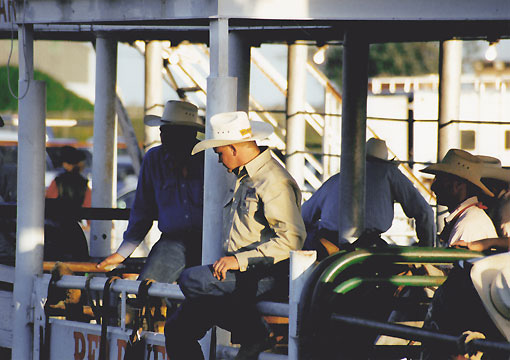"The Chutes" at the Top O'Texas Rodeo (copyright 2000)
Presenting the Colors (copyright 2000)
I remember when my Dad introduced me to my new family when I was 13 years old after my mother had died two years earlier. We would be moving from South Denver, Colorado to Littleton where my new step family lived. I suddenly gained 3 brothers and a sister in the deal. I would be the youngest. My biological mother had loved to paint. Her favorite topic was horses. She loved horses and so did I. I always wanted a pony, but living in the big city meant that wasn’t possible. So I thought it was really cool when we moved to Littleton on the little acreage and I met my brother Dale. He was a real rodeo cowboy. I got to exercise his horses for him and sometimes help out with moving cattle around in our arena when he practiced roping. I got to attend rodeos like the Greeley Independence Day Stampede where I sat on the chutes with the performers.
Rodeo type competitions have been around for a long time. They may date back to the Greeks and Minoans where bull wrestling and bull jumping was practiced. The American version probably came from Spain. As the Spanish Conquistadores moved up into the southwestern United States on their explorations of the New World they brought with them their horses and cattle and their ways of handling the stock. These had developed from the sports of Spanish bull fighting and cattle wrangling. The vaqueros had rodeos of sorts but they didn’t look like the American version of today. [1]
American rodeo started from everyday ranching activities such as roping calves that strayed from the herd or for branding and taming horses.[2] In Texas with its extensive grasslands cattle were fed and then herded long distance to market in large cattle drives. Some of the names are familiar especially to those in the Texas Panhandle, names like John S. Chrisom, Oliver Loving, and Charles Goodnight. Young men began to join these cattle drives and the American cowboy was born. As the railroads were builto into the southwest it became much more profitable to keep cattle on large ranch holdings where they didn’t have to make the arduous trip to market. This meant they remained fatter and brought more money when sold. The cowboys of the trail drive settled on ranches such as the XIT of the Texas Panhandle. As is the case when a bunch of guys get together they decided to compete with each other during their off time. They competed in the skills that they had acquired on the trail and on the ranches and the American rodeo was born.[3] Soon the competitions began to spread and at the same time Wild Bill Cody started his Wild West Show exhibiting western lifestyles to the people of the east and mid west and even Europe. Rodeo type exhibitions and the Wild West shows went hand in hand. Rodeo and anything “western” was exciting for people of the east coast[4]
After WWI rodeo became even more institutionalized. Madison Square Garden put on a rodeo in 1922 overshadowing Cheyenne Frontier Days which had been the premier rodeo to that point. In the early 1930s rodeo associations were formed to govern events and to make sure that cowboys were paid fairly. To that point some promoters took advantage of the performers and kept more of the prize money than they handed out. Many rodeos claimed to be the “championships,” which caused a lot of confusion. In 1958 the National Finals Rodeo was started, giving rodeo a national TV audience. Rodeo had joined the world of big business and big media. The NFC has been held in Las Vegas, Nevada since 1985.[5] The history of rodeo is much more extensive than covered here. There are many venues, Omak Stampede, Greeley Stampede, Pendleton Roundup and Cheyenne Frontier Days to name just a very few.
The pictures here were taken at the Top of Texas Rodeo in Pampa, Texas in the northern part of the Texas Panhandle in 2000. This rodeo was started when some Pampa businessmen were meeting for coffee and decided it would be a great idea to provide some kind of entertainment for the people of Pampa. It made sense to let the cowboys and girls of the area show off their skills. The Top O’ Texas Rodeo Association was born. This rodeo has been held annually since then except for 1970 and 71. In 1970 a tornado tore apart some of the stands in the arena and in 71 there was quarantine on Panhandle livestock do to Venezuelan Equine Encephalomyelitis. [6]
The city of Pampa is the second largest city in the Panhandle. It was built up due to oil and its allied industries and became a market center for agriculture and livestock.[7] The Santa Fe Railroad was constructed through the area in 1888. A train station and telegraph office as built and the town site established by George Tyng who was he manager of the White Deer Lands ranch. People settled and developed the land sold by Timothy Hobard. Gas and oil were discovered in the Panhandle in 1916 and in the resulting oil boom Pampa prospered. In 1928 it became Gray County seat. [8]
[1] http://en.wikipedia.org/wiki/History_of_rodeo
[2] http://en.wikipedia.org/wiki/History_of_rodeo
[3]http://www.tshaonline.org/handbook/online/articles/llr01
[4] . http://en.wikipedia.org/wiki/History_of_rodeo
[5] http://en.wikipedia.org/wiki/History_of_rodeo
[6] http://topoftexasrodeo.com/
[7] http://www.cityofpampa.org/


No comments:
Post a Comment